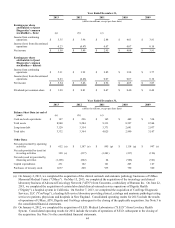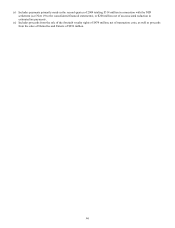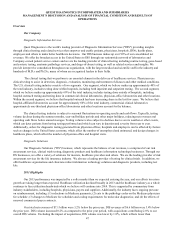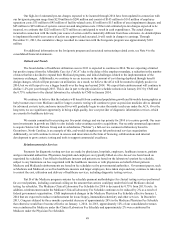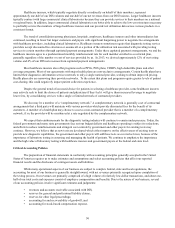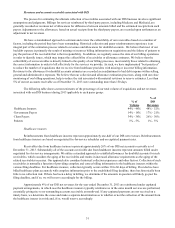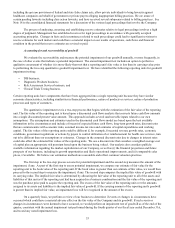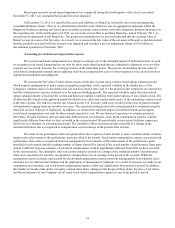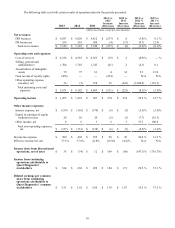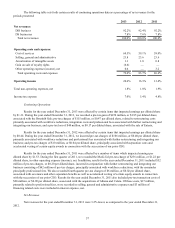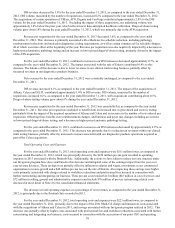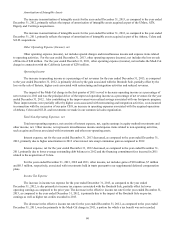Quest Diagnostics 2013 Annual Report Download - page 56
Download and view the complete annual report
Please find page 56 of the 2013 Quest Diagnostics annual report below. You can navigate through the pages in the report by either clicking on the pages listed below, or by using the keyword search tool below to find specific information within the annual report.52
Government payers
Payments for diagnostic testing services made by the government are based on fee schedules set by governmental
authorities. Receivables due from government payers under the Medicare and Medicaid programs represent approximately 14%
of our DIS net accounts receivable as of December 31, 2013. Collection of such receivables is normally a function of providing
the complete and correct billing information within the various filing deadlines. Collection typically occurs within 30 days of
billing. Our processes for billing, collecting and estimating uncollectible amounts for receivables due from government payers,
as well as the risk of non-collection, are similar to those noted above for healthcare insurers under negotiated fee-for-service
arrangements.
Client payers
Client payers include physicians, hospitals, employers and other commercial laboratories, and are billed based on a
negotiated fee schedule. Receivables due from client payers represent approximately 40% of our DIS net accounts receivable as
of December 31, 2013. Credit risk and ability to pay are more of a consideration for these payers than healthcare insurers and
government payers. We utilize a standard approach to establish allowances for doubtful accounts for such receivables, which
considers the aging of the receivables and results in increased allowance requirements as the aging of the related receivables
increase. Our approach also considers specific account reviews, historical collection experience and other factors.
Patients
Patients are billed based on established patient fee schedules, subject to any limitations on fees negotiated with
healthcare insurers or physicians on behalf of their patients. Receivables due from patients (including coinsurance
responsibilities) represent approximately 20% of our DIS net accounts receivable as of December 31, 2013. Collection of
receivables due from patients is subject to credit risk and ability of the patients to pay. We utilize a standard approach to
establish allowances for doubtful accounts for such receivables, which considers the aging of the receivables and results in
increased allowance requirements as the aging of the related receivables increases. Our approach also considers historical
collection experience and other factors. Patient receivables are generally fully reserved for when the related billing reaches 210
days outstanding. Balances are automatically written off when they are sent to collection agencies. Reserves are adjusted for
estimated recoveries of amounts sent to collection agencies based on historical collection experience, which is regularly
monitored.
Reserves for general and professional liability claims
As a general matter, providers of diagnostic testing services may be subject to lawsuits alleging negligence or other
similar legal claims. These suits could involve claims for substantial damages. Any professional liability litigation could also
have an adverse impact on our client base and reputation. We maintain various liability insurance coverages for claims that
could result from providing, or failing to provide, diagnostic testing services, including inaccurate testing results, and other
exposures. Our insurance coverage limits our maximum exposure on individual claims; however, we are essentially self-insured
for a significant portion of these claims. While the basis for claims reserves considers actuarially determined losses based upon
our historical and projected loss experience, the process of analyzing, assessing and establishing reserve estimates relative to
these types of claims involves a high degree of judgment. Changes in the facts and circumstances associated with claims could
have a material impact on our results of operations, principally costs of services, and cash flows in the period that reserve
estimates are revised or paid. Although we believe that our present reserves and insurance coverage are sufficient to cover
currently estimated exposures, it is possible that we may incur liabilities in excess of our recorded reserves or insurance
coverage.
Reserves for other legal proceedings
Our businesses are subject to or impacted by extensive and frequently changing laws and regulations, including
inspections and audits by governmental agencies, in the United States (at both the federal and state levels) and the other
jurisdictions in which we conduct business. Although we believe that we are in compliance, in all material respects, with
applicable laws and regulations, there can be no assurance that a regulatory agency would not reach a different conclusion.
Any noncompliance by us with applicable laws and regulations could have a material adverse effect on our results of
operations. In addition, these laws and regulations may be interpreted or applied by a prosecutorial, regulatory or judicial
authority in a manner that could require us to make changes in our operations, including our pricing and/or billing practices.
We have, in the past, entered into several settlement agreements with various government and private payers relating to
industry-wide billing and marketing practices that had been substantially discontinued. The federal or state governments may
bring claims based on our current practices, which we believe are lawful. In addition, certain federal and state statutes,




